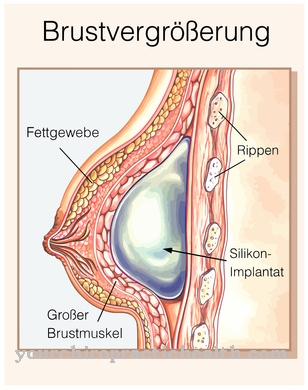There are now a wide variety of ways to avoid pregnancy. The is becoming more and more popular Hormonal IUD. Although it is considered a very reliable method of contraception, it also carries risks.
What is the IUD?

The IUD is known as the intrauterine system, especially in medical circles. It is a plastic body about three centimeters long. Due to its curved shape, the hormonal IUD is reminiscent of a T. It is inserted into the uterus like any other IUD. The procedure is usually performed under local anesthesia and on an outpatient basis. The biggest difference to the conventional spiral is the way it works.
This is not based on copper ions, but on the artificially produced hormone levonorgestrel. Overall, the risk of pregnancy under the IUD is very low. The safety is roughly equivalent to that of sterilization. However, external influences and application errors by the doctor can lower the Pearl Index.
Function, effect & goals
Ultimately, the aim of the hormonal IUD is to avoid unwanted pregnancy. It is increasingly used by women who already have children and whose family planning has been completed. Because of the risk of infertility, a different method of contraception is usually recommended for young girls.
Once transplanted into the uterus, the preventive effect is immediate. Usually this lasts five years. Then the spiral must be removed or replaced if necessary. The release of hormones occurs locally. As a result, a far lower proportion of artificial hormones enter the female body than is the case, for example, with the birth control pill. The IUD evenly releases the corpus luteum hormone levonorgestrel. This ensures that the mucus in the cervix takes on a thick consistency.
This makes it more difficult for sperm to find their way to the egg cell. If individual sperm cells penetrate further, the levonorgestrel restricts their activity. In addition, it works in the woman's uterus. In this way, the hormone coil suppresses or prevents ovulation. This is necessary for pregnancy. The lining of the uterus changes in such a way that it is impossible for the egg to implant. Women often see a decrease in blood during their period after using the IUD. In addition to prevention, the IUD can reduce heavy bleeding and relieve menstrual cramps.
A gynecologist must be consulted to have an IUD inserted. During an examination, the doctor first determines whether the contraceptive method is even suitable. Some tests are also ordered to rule out infections and pregnancy. If the last test to check for cervical cancer was more than six months ago, it must be renewed. Then the IUD can be used. The procedure should be performed during menstruation because the cervix is open during menstruation and makes insertion easier.
Upon request, the patient is given one of the various anesthetic options; the vagina and cervix are disinfected to prevent bacteria from entering. An applicator helps to get the IUD into the correct position. If the coil is optimally anchored in the uterus, it opens its arms. Any protruding threads are shortened. The mission ends with an ultrasound examination to check the position of the hormone coil. After about four to twelve weeks, another review of the situation is due.
This first examination is often covered by health insurance companies. The position should then be made visible every six months using an ultrasound image. In addition, women can regularly check the fit of the spiral by feeling the return threads. The hormonal IUD is particularly suitable for women who want long-term contraception. Due to the local release of the hormones, the side effects are usually weaker than when taking the pill.
Risks, side effects & dangers
The hormonal IUD offers advantages, but also carries risks, which those interested should find out about before use. It cannot be ruled out that the spiral may slip or be ejected. In most patients, however, such an event occurs in the first two months after the procedure. As soon as the hormonal IUD changes its position, an unwanted pregnancy can occur.
Such an incident can be revealed by a check-up. Regular palpation of the sutures can rule out the possibility of the coil being expelled during menstruation. If pregnancy occurs under the hormonal IUD, the risk of an ectopic pregnancy is increased. This presents dangers for mother and child. Because the embryo cannot grow in its unfamiliar environment, the female body often rejects it on its own. Furthermore, there are side effects from the hormonal IUD. For example, patients complain of various pains in the head, abdomen, chest and back.
The risk of breast cancer and thrombosis is higher than in women who do not use hormonal contraception. It can lead to inflammation of the labia, pelvis and uterus. On the psychological level, some women suffer from depressive moods, mood swings, loss of libido and nervousness. Young women with plans for children should refrain from an IUD. The same applies to breastfeeding mothers because the hormone it contains can get into breast milk. The costs are around 350 euros and are only covered by health insurance in some cases. In order to avoid a personal payment, medical reasons must speak in favor of the IUD.





.jpg)



















.jpg)

.jpg)
